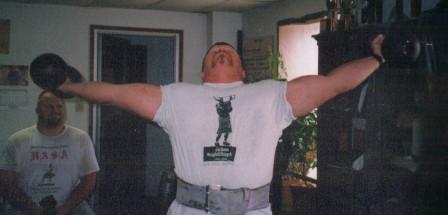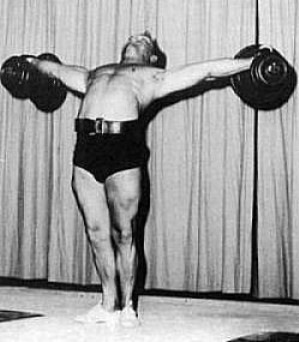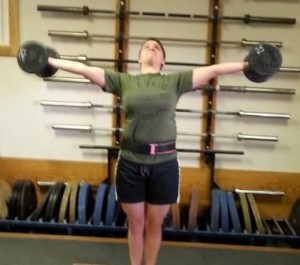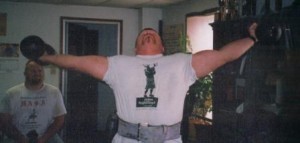by Al Myers

Eric Todd and his USAWA record performance in the Crucifix, with a lift of 140 pounds at the 2005 Deanna Springs Memorial Meet.
I think it is only appropriate to HIGHLIGHT the best lifts ever in the Crucifix since it is our signature lift, as demonstrated by the USAWA logo. The rules of the Crucifix are often misunderstood. People will assume it is the same as other similar lifts like the Iron Cross, Muscle Out or Side Lateral, but the Crucifix Lift is much different. The USAWA Rules of the Crucifix Lift is as follows:
Two evenly loaded dumbbells or kettlebells are used for this lift. The lift begins at the lifter’s discretion. The dumbbells are taken to arms’ length overhead with the palms of the hands facing each other and dumbbells touching. The lifter must bring the feet together so the heels are together and touching. The body must be upright at the start of the lift. Once in this position, an official will give the command to start the lift. The lifter will then lower the dumbbells to the side with arms’ straight and palms up. Elbows must be fully locked. The lifter may lean back to any extent when lowering the dumbbells. The wrists do not need to be held straight. The legs must remain straight and knees locked throughout the lift. The heels must remain together and the heels and toes must not rise during the lift. Once the arms are parallel to the platform, and the dumbbells motionless, an official will give a command to end the lift.
The best All-Time USAWA lift in the Crucifix is held by Eric Todd, with a lift of 140 pounds performed at the 2005 Deanna Springs Memorial Meet in the 110K Class. This lift was judged under the strict judging of Bill Clark. Eric holds a couple of other weight group records with lifts of 130 pounds and 120 pounds, so he is the REAL DEAL when it comes to the Crucifix Lift. I have competed several times in meets with Eric when the Crucifix was being contested, and I am always amazed at what he does. Only four other USAWA lifters have ever done over 100 pounds – these being Sam Huff, Mike McBride, Bill Spayd, and Ed Schock (who has the top Master Lift in the Crucifix at 100 pounds). The top teenager in the Crucifix is Abe Smith, who did 70 pounds. Amokor Ollennuking has the top female lift in the USAWA with a lift of 60 pounds.

The famous picture of Joe Southard, performing a Crucifix Lift of 130 pounds in 1963.
What is the best Crucifix in history? I did some research and their are several “claims” but most seem to have not been verified. I consider Louis Cyr to be the best in history. Cyr did a Crucifix with 94 pounds in the right hand, and 88 pounds in the left, for a total weight of 182 pounds. Marvin Eder and Doug Hepburn both were credited with a “Crucifix- like lift” of 100 pounds per hand, but were judged “less than strict”. Among Old-Time Strongmen, George Hackenschmidt did a Crucifix 0f 180 pounds in 1902. But even Hackenschmidt said in his own words that it was performed “in a less strictly correct style”.
One thing is certain – the description and rules of the Crucifix has been different throughout history, and not always conforming with today’s set USAWA rules. Actually, the USAWA rules make the Crucifix as difficult as possible with these criteria: heels being together throughout, elbows fully locked at finish, and the lift being completed upon official’s command, thus requiring the weight to be momentarily paused. Joe Southard, the great Illinois All-Rounder, did 130# in the Crucifix at 165# bodyweight in 1963. This was considered the World Record for quite some time for a competitive Crucifix Lift. The picture of Joe Southard doing this record became well known to USAWA lifters, as it graced the cover of our Rule Book for several years. But look at the picture closely – and you will notice the dumbbells Southard was using were not loaded evenly on both ends, which would not comply with today’s USAWA Rules. How much that would help I have no idea. Another couple of lifters who excelled at the Crucifix in the Mo-Valley All-Rounds (before the USAWA was formed) was Steve Schmidt (110# Crucifix at 220# BW in 1985) and Bob Burtzloff (100# Crucifix at HWT in 1982). Both of these lifts were officiated under the same rules as we use today.
The Crucifix has only been performed in one meet in the USAWA these past few years, and that is the Deanna Springs Memorial Meet, hosted by Bill Clark. It is in the Deanna Meet EVERY year, as the events in that meet don’t change. The Crucifix Lift is the perfect example of a true “odd lift”, and for this reason makes a great “poster lift” for the USAWA .



